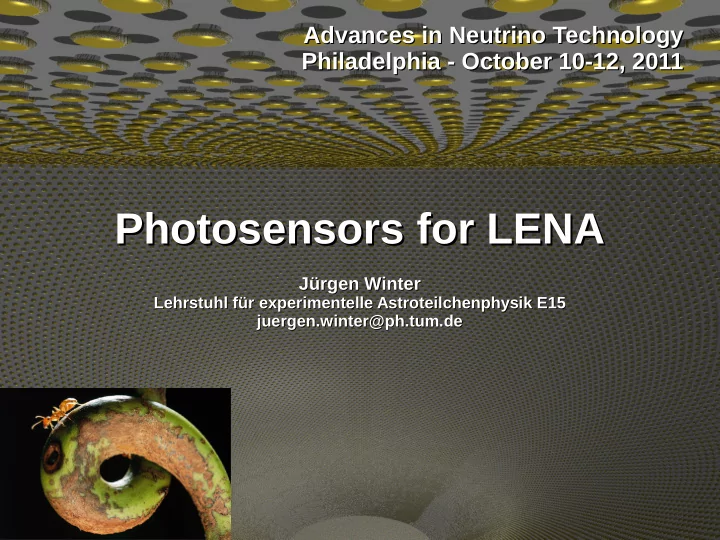

Advances in Neutrino Technology Advances in Neutrino Technology Philadelphia - October 10-12, 2011 Philadelphia - October 10-12, 2011 Photosensors for LENA Photosensors for LENA Jürgen Winter Jürgen Winter Lehrstuhl für experimentelle Astroteilchenphysik E15 Lehrstuhl für experimentelle Astroteilchenphysik E15 juergen.winter@ph.tum.de juergen.winter@ph.tum.de
Overview ● LENA photo sensor requirements ● Important PMT characteristics ● PMT characterisation ● Alternative photo sensors ● Summary
LENA Design Inner Detector ( 50 kt LSD) Photo sensor Desired optical coverage: requirements 30% → 3,000 m² effective photo- 30 m ● Sensor sensitive area performance ● Environmental PMT Ø # PMTs in ID properties No light Light concen- ● Availability concentrators trators (1.75) ● Cost-performance 100 m 5'' 329,300 188,200 ratio 8'' 110,400 63,000 10'' 82,300 47,000 PMTs are probably the PMTs are probably the 20'' 21,600 12,300 only photo sensor only photo sensor type which can fulfill type which can fulfill Muon Veto (100 kt WCD) all requirements all requirements with 5,000 8'' PMTs
PMT requirements Sensor performance ● Photo detection efficiency ● and spectral response Detector performance Time jitter ● ● Spatial resolution ● Tracking Afterpulses ● ● Energy resolution Dynamic Range ● ● Time resolution ... ● Energy threshold ● ● Particle discrimination Environmental properties ● ● Event topologies Radiopurity ● Pressure resistance ● Design ● Optical coverage Physics Programme Physics Programme ● Granularity ●
PMT properties ● Photo detection efficiency Quantum efficiency of photocathode ● Photo electron collection efficiency ● Backscattering losses ● ● Spectral response Should match spectrum of scintillation light ● Bialkali photocathode best choice ● Peak senitivity at 430 nm ● LENA benchmark value: 20 % at 420 nm LENA benchmark value: 20 % at 420 nm
PMT properties ● Optical coverage Light concentrator to increase area ● → influence on energy+time+spatial resolution LENA benchmark value: 30 % LENA benchmark value: 30 % ● Granularity Number of photosensors ● → increasing spatial resolution for increasing granularity high granularity vs cost optimization high granularity vs cost optimization
PMT properties ● Time jitter → time and position resolution LENA: ~ few ns LENA: ~ few ns ● Pulse shape Rise and fall times of the spe voltage pulses ● → tracking and position reconstruction ● Dynamic Range Low-E : 1 p.e. per sensor ● High-E: 100s of p.e. per sensor ● LENA: spe – 0.3 pe/cm² LENA: spe – 0.3 pe/cm² ● Afterpulses (<5%) Might fake double peak coincidences (e.g. proton decay) ●
PMT properties ● Gain, single electron resolution Large peak-to-valley ratio ● → LENA: peak-to-valley >2 LENA: peak-to-valley >2 ● Dark count (<15 Hz qm) Might cause random coincidences ● → position and energy resolution, energy threshold ● Environmental properties Radioactive purity ● 238 U content <3∙10 -8 g/g Pressure resistance: up to 13 bar 13 bar 232 Th content <1∙10 -8 g/g ● Long-term reliability: 30 yrs 30 yrs nat K content <2∙10 -5 g/g ●
PMT characterisation at TUM ● Setup to determine PMT properties ● Pulse shape: TTS, LP, BP, PreP ● Afterpulsing: fast, ionic ● Dynamic range Collaborations with MEMPHYS (PMm2), ● KM3Net INFN Milano, LNGS, ● Tübingen ETEL, Hamamatsu ●
PMT characterisation at TUM • Light sources: • Pulsed ps diode laser : Edinburgh Instruments EPL-405-mod, 403nm, pulse width 48ps, 2 kHz-2 MHz • Fast LED driven by avalanche diode: 430nm, time jitter (FWHM) <≈1ns • PMTs from Hamamatsu and ETEL • FADC readout • Planned – Wiston cones At the moment no ● At the moment no – Fiber to scan conclusive decision possible : conclusive decision possible : photcathode ~ ~ 10 PMTs/series needed ● 10 PMTs/series needed – SiPMs Simulation to determine limits + Simulation to determine limits + ● implications better implications better
Light collectors ● MC simulations of light concentrators with Geant4 ● Incorporate results into optical model of detector (Geant4 MC) → determine optimum light concentrator ● Build prototype ● Use new setup to scan over aperture and incident angles of winston cones Borexino WC
Pressure encapsulation ● PMTs have to withstand up to 11 bar (+ shock wave) → encapsulation ● Calculations with SolidWorks: ● Finite elements calculation ● different encapsulation shapes for different PMT types → Steel thickness >0.5 mm → Acrylic glass: >3-4 mm
Other photosensors • Quasar (Baikal): solid scintillator block + PMT + small jitter even for large photocathodes, excellent energy resolution - price ● Hybrid-Gas Photomultiplier : photocathode in vacuum + THGEM • SiPM: array of small APDs + excellent TTS (FWHM< 0.5ns), excellent energy resolution - immense cost/area; huge dark count (100kHz- Mhz), cooling needed • Qupid/ Hybrid Photo-Detector: Photocathode + APD ● Microchannel Plate (MCP): Photocathode + thin etched channels In all cases - further investigation and characterisation needed - price reduction - reliabilty → PMTs still favoured solution
Conclusions ● PMT considered most feasible candidate at the moment ● Approximate limits on photosensor properties known → do simulations to refine values ● tested promising PMT (test SiPMs and Hybrid Phototubes in future) ● development of pressure-withstanding optical modules for PMTs ● Development of Winston cones
Recommend
More recommend